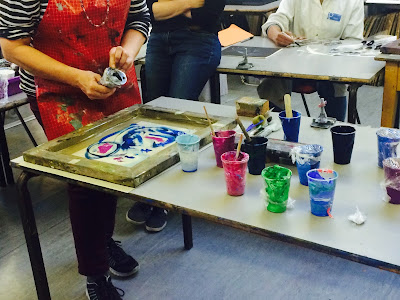I first learnt to screen print in 2006. Since then I did a couple of refresher course, as well as having a sabbatical in 2010 when I dedicated a couple of months screen printing part time. Since then I have screen printed on and off on Saturdays sporadically as work was getting quite busy.
Given the limited time and also the expense for screen prints, it really pays to be organised and efficient in managing the screen printing process.
At the same time, I want to enjoy the process and not rush through it, so I also tend to be quite realistic and do not try to do too much in a session.
In the beginning I just brought everything with me and took out what I need from the bag, it wasn't organised and the process ended up being stressful, unproductive and it always ended up being a bit of a mess and I dreaded the sessions. I have now done enough to know to be organised and methodical and the sessions are actually rather enjoyable.
I have now developed a checklist and a systematic approach that I would like to share with everyone who is starting to screen print and you may find it useful. I do understand everyone is different and have different habits so by all means modify it to suit your needs.
CHECKLIST TO BRING
1. Paper for printing - usually pre-cut, and also a little bit more than I plan to print in case there are mistakes.
2. Testing papers - these are the testing paper for trying out before printing on the good papers. I use the back of the failed prints as well as newsprint.
3. Scissors - cutting tapes and paper as necessary
4. Brown tape - totally indispensable - for masking gaps in the printing screen when the emulsion is not done properly, and also for wrapping around the screen itself 's inner edges
5. Masking tape - for positioning the paper on the screen bed for printing
6. testing tracing paper - for testing out where to position the paper on the bed after the screen is locked in place ready to print
7. pencil, a small brush and a ruler, just my standard pencil case items.
8. 2 clean towels - one for wiping out excessive paint and one for drying area with water and minor dirt marks, I also keep one dirty and the other relatively clean
9. the actual screen printing frame ( you can rent but i have my own)
10. Paint in tubs already mixed, or paint with some spare tubs in case I want to do some mixing. I find a ready mixed 250ml paint is usually enough for at least 60 pages of A3.
11. Medium - for mixing with paint if I haven't mixed the paint already.
12. printing apron
EXTRA CHECKLIST ( SOME EXPECTS YOU TO BRING YOUR OWN)
1. Sponge for washing up
2. Squeegee for printing and pressing against the screen frame mesh
3. Mixing stick - for mixing paint and medium
4. Spatula - perfect for scrapping excessive paint on the screen after the screen printing session
5. water bucket
CHECKLIST FOR SET UP
Once at the studio I like to spend 15 mins to set up everything neatly and efficiently, so they are all within reach and I know exactly where things are.
1. Firstly make sure the area is clean and safe. Make sure the screen bed is set up the way you want and it is clean and don't have paint on them ( I have had perfect prints ruined by bits os paint on the screen bed I didn't see)
2. Set up a small clean table on the side to place extra things. Make sure the drawing rack you use are all clear up.
3. On the small table I will put some clean scrap paper on the table to lay down my good and testing papers.
4. Under the small table I put the paint and medium that I don't use immediately, a water bucket and a sponge for cleaning and washing so these are all out of the way.
5. On the right hand side of the screen bed - I lay down newspaper to cover that side of the bed and secure with masking tape. This is where I put the paint and spatula I use for that particular session, and a towel for dealing with dirty paint.
6. On the left hand side of the screen bed - I lay down newspaper to cover that side of the bed and secure with masking tape. This is whew I put the tools such as brown and masking tapes, as well as the pencil case and the clean towels on this side.
7. In the centre of the screen bed - I secure the screen, and have a clean piece of tracing paper secured with brown tape on my side of the screen bed.
CHECKLIST FOR PRINTING
1. Do a test print on the trace paper when first trying to locate where to put the paper
2. Use the squeegee to coat the screen away from you when the frame is still up
3. Then bring the frame down, and wipe the squeegee towards you and print
4. repeat step 2 and coat the screen
5. Make sure the hands are cleaned when transferring the paper to the rack, and only touch the opposite corners of the papers edges.
Overall, the key is don't rush, take your time. Tweak the above steps to suit your needs but the important thing is to be organised and do it methodically. Not only will you be more productive and efficient, you will also really enjoy the whole process of screen printing.











